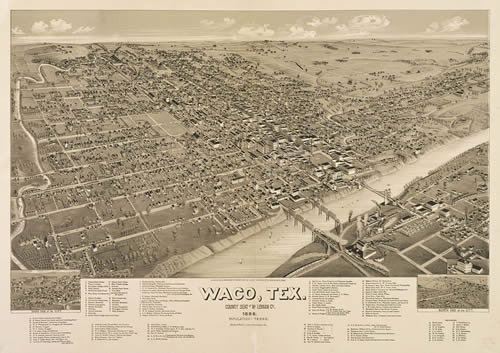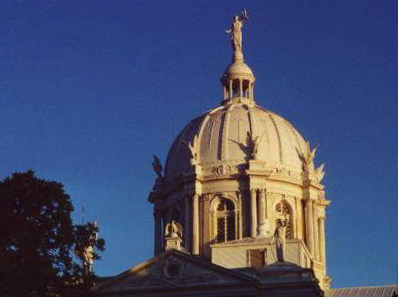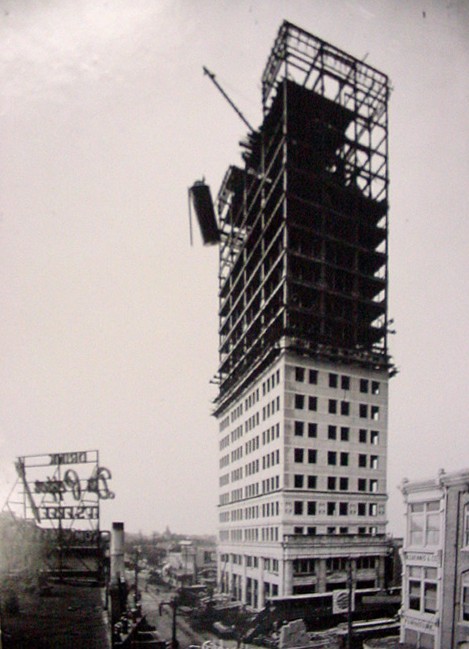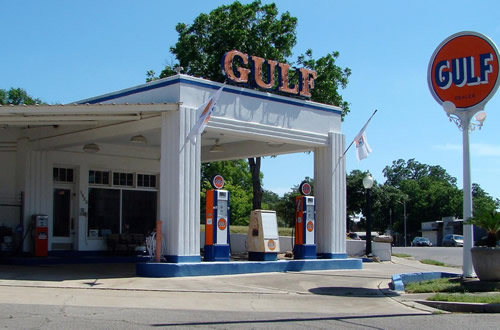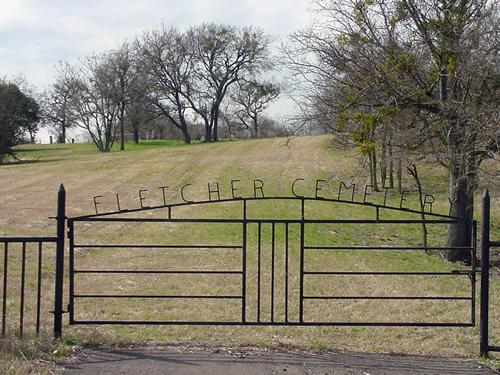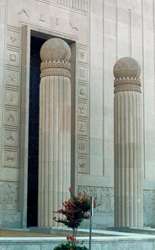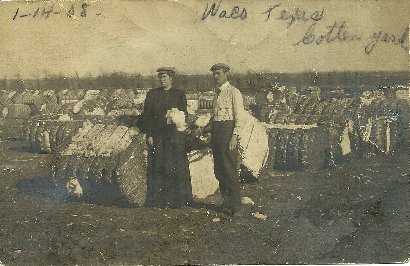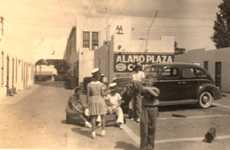Waco, Texas, McLennan County seat. (original) (raw)
Camp MacArthur Mess Line, Waco Texas 1918
WWI
Postcard courtesy www.rootsweb.com/ %7Etxpstcrd/
History in a Pecan Shell
The city is built near springs that used to flow not far from downtown Waco (still marked - on the grounds of a former elementary school (more recently the Helen Marie Taylor Museum).
A timeline of significant events in Waco
1837: Fort Fisher, a Texas Rangers outpost was established in but abandoned within the year.
1838: Neil McLennan moved onto land nearby on the South Bosque River, a somewhat romantic mural commemorating the event is in the post office in nearby Mart, Texas. Land agent Jacob De Cordova accquires the property and has George B. Erath survey the area. Erath had first visited the area as a ranger stationed at Ft. Fisher.
1849: Geo. Erath laid out the first block of the new town that they first wanted to name Lamartine.
1850: McLennan County was organized. The Waco Era, the town's first newspaper is published.
1856: Waco Village is incorporated as the town of Waco and a new courthouse is built that year.
The Civil War: Seventeen companies of Confederate soldiers were raised from Waco and the surrounding countryside. Waco also produced six Confederate generals. After the Civil War, Waco's economy recovered rapidly despite the trials of reconstruction.
1868: Waco becomes a spur on the Chisholm Trail and cattlemen and their cowboys often stopped in Waco for suppies and entertainment.
1870: The Waco Bridge Company opened a suspension bridge spanning the Brazos. Designed by Robeling - the man who went on to build the Brooklyn Bridge - the Waco bridge served as his working model.
1871: The Waco and Northwestern Railroad was built.
1872: The African Methodist Episcopal church opens Paul Quinn College (now in Dallas)
1880s: Two other railroads, the St. Louis and Southwestern and the Missouri-Kansas-Texas lines, came to Waco in the early 1880s.
1884: The population reaches 12,000. 50,000 bales of cotton were being shipped through Waco annually. During the 1880s and 90s artesian wells were expanded and two natatoriums were built - one of them a hotel built by J. Reily Gordon who later built the McLennan County courthouse in 1901.
1887: Waco University merges with Baylor U., which had moved to Waco from Independence, Texas.
1890: Waco had streetcars pulled by mules and began to build a system of parks, often with donated land.
1898: Waco industries include railroads, ice plants, flour mills, foundries, boiler plants, and bottling works.
1900: Waco becomes the 6th largest city in Texas.
190I: Twenty electric trolleys were operating on city streets and the Beaux-Arts courthouse was finished.
1905: a street paving program began
1909: The Cotton Palace was built, and soon became one of the most popular fairs in the south; in 1913 an estimated 500,000 people visited the site.
1911: The Amicable Insurance Building, at twenty-two-stories becomes the tallest building in Texas
1913: An electric interurban railway opened between Waco and Dallas.
1917: Camp MacArthur opens (1917 to 1919) an infantry training base covering more than 10,000 acres The 35,000 troops assigned to the camp doubled Waco's population.
"The Reservation" - Waco's licensed red-light district since the 1870s is shut down this year.
1930: population reaches 53,848
The Cotton Palace, a symbol of the city's prosperity, was shut down. It later burned.
Based on a fear of not appearing "progressive"- the electric trolleys were discontinued and replaced with buses.
1940: 55,982 people lived in Waco
World War II revives the cotton industry and Waco Army Flying School and Blackland Army Air Field (China Spring) were opened.
1948: Waco Army Air Field was reactivated as Connally Air Force Base
1952: population was 84,300
1953: A tornado nearly levels downtown. Hundreds of people were buried in the rubble of buildings whose brick walls were not braced. The loss of nearly 600 downtown buildings is still evident today.
1966: Connally Air Force Base is closed
1970: the population was 95,326
1980: population reaches 101,216
1990: population was 103,590
1886 Bird's eye view of Waco, Texas
Clcik on image to enlarge
Wikimedia
Waco, Texas Landmarks / Attractions
Photo Courtesy Texas Collection, Baylor University
c. 1911 - The tallest building in Texas when it was first built. Built over artesian springs, the building was self-sustaining. Employees of the building witnessed the destruction of downtown Waco during the 1953 tornado.
 |
Bridges crossing the Brazos at Waco Waco Suspension Bridge: c. 1870, The Waco Steel Bridge AKA The Washington Street Bridge, The Iron Bridge c. 1902, The Interurban Railway Bridge c.1910, Union Pacific Bridge |
|---|
Armstrong Browning Library:
On the campus of Baylor University- World's largest collection of Robert and Elizabeth Barrett Browning's works and memorabiliaMayborn Museum Complex:
Governor Bill and Vera Daniel Historic Village -
"...Bill Daniel is best remembered by some admirers for one of the strangest events in East Texas--the move of an entire town from Liberty to Waco, a distance of more than 200 miles, in October of 1986 during the Texas sesquicentennial celebration..."
Baylor campus. www.maybornmuseum.comHomestead Heritage Crafts Village:
a 350 acre 19th century working farmTexas Ranger Hall of Fame and Museum:
On the Brazos River at the site of old Fort FisherDr Pepper Museum: Building c. 1906
Historic Homes Tour:
Contact the visitor's bureau for information 1-254-750-8696The Crash at Crush by Luke Warm
The field that once was Crush, Texas is now occupied by cows, but a recently replaced historical marker south of West, Texas tells the story of one of the most bizarre publicity stunts of all time... Read full articleWaco Mammoth Site Nearing National Monument Status by Britt Towery
Last month the U.S. Congressional committee approved the Waco Mammoth Site to become a national monument...This was the biggest hurdle so far in the ten-year struggle to protect the site of a mammoth herd's death just north of Waco. This is the world's largest known concentration of prehistoric mammoths perishing in the same event... Read full articleMayhem at Mount Carmel by Mike Cox (Excerpt from "Time of the Rangers")
On any given Sunday morning in Waco, home of the largest Baptist university in the nation, a lot of the city�s residents are sitting in church. That was where Company F Captain Bob Prince could be found on the morning of February 28, 1993... A Texas National Guard helicopter had been shot down and numerous federal Bureau of Alcohol, Tobacco and Firearms agents killed and wounded while attempting to serve a search warrant at David Koresh�s Branch Davidian ranch... Read full article
 |
Lover's Leaps by Mike Cox The best known Lover's Leap in Texas is the cliff overlooking the Brazos River in Waco's Cameron Park. It's such a well known landmark that there's a church named after it - Lover's Leap Baptist... Read full article |
|---|
Photo courtesy Richard Wilshire
Photo courtesy Charles Watson
Waco, Texas Chronicles
Waco Native Sons & Daughters
- Hello, Sucker by Clay Coppedge
Necessity may be the mother of invention but it can also be the mother of re-invention. Other than perhaps Kinky Friedman, nobody exhibits that twist on the old axiom more than Mary Louise Cecilia Guinan, known to history as Texas Guinan and for her famous greeting: �Hello, Sucker.� - Texas Guinan by Luke Warm
She may have been Waco's Answer to Mae West - but no one remembers the question... - Doris Miller: Hero by Archie P. McDonald
African American hero of WWII - Sleeper's Song by Mike Cox
As a long-time Texas lawyer, Ben Sleeper wrote many a legalese-laden petition alledging this or that in behalf of his clients, but few if any of them ever knew of � much less heard � the patriotic song he composed as a young Army officer in training back during World War I.
Tenting on the old camp grounds, Waco Texas 1918
WWI
Postcard courtesy www.rootsweb.com/ %7Etxpstcrd/
Waco Architecture: Gone but not Forgotten
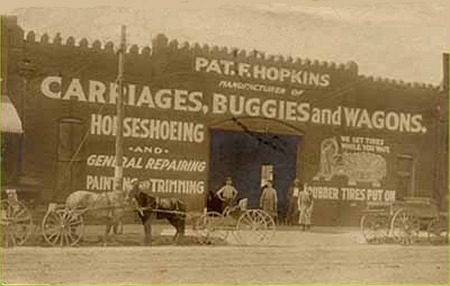
Hopkins Carriages, Buggies and Wagons
1908
Postcard courtesy www.rootsweb.com/ %7Etxpstcrd/
Waco's Alamo Courts
Photo circa 1940s courtesy George Lester
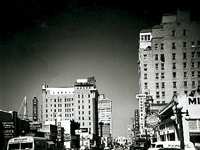
Downtown Waco in the 1950s
Photo courtesy of TXDoT
Waco's location and its involvement in so many historical Texas events and developments makes it one of Texas' most interesting towns. Fortunately, Waco has a very active historical society which has printed a historical magazine for many years. An Illustrated History of Waco in two volumes has been published by Texian Press, a Waco company with a strong personal involvement in the project.The unfortunate events that took place at "Mount Carmel" have linked the name Waco with those events. It's our sincere hope that people will eventually forget this association and that Waco will be known for what it is and has been, and not for a single incident. - Editor

"In 2008 I had the privilege of flying on the 'Spirit of Waco' with retired Air Force pilot who had piloted one of these A-26 Bombers during an air show inn Waco - Richard Wilshire, November 21, 2022
- Subject: Waco forgotten history
A history of the Headquarters 12th Air Force 1957-68 Waco, Texas.
In the years following the Korean War and the build-up of the nuclear US Air Force in the mid to late 1950�s the offices of the 12th Air Force were established in Waco, Texas near where 25th Street and Windsor Ave intersect. The mission of the command was to prepare and train tactical forces of the Air Force to work jointly with the Army for units located west of the Mississippi River. They played a key role developing tactics and methods of these forces during the increasing US presence in Southeast Asia. The offices were located in two major buildings facing 25th Street with a small office housing an officer club near Bosque Blvd and 25th. This facility was used until the command was relocated to Bergstrom AFB, TX in 1968. The buildings were abandoned and turned over to their previous owners, presumably the City of Waco.
The headquarters were not located at nearby James Connelly AFB as some sources write.
My father, SSgt Robert Torn was stationed there 1961-1963 as an administration clerk assigned to the fledgling Direct Air Support Center (DASC) and part time bartender at the Officer�s club.
No photos are available of the facility despite its 10 year location at the site. - September 16, 2014 - Rich Field, Waco
I am looking for information on anything to do with Rich Flying Field, in Waco. This was home to a unit of the Air Force of France, the US Army Flying Service, and U. S. Signal Corps. This World War I base was located near 42nd street in Waco and was the basis for Richfield High School (now Waco High School) . My father served at Rich Flying Field in 1918. USAF records are slim concerning WWI because of the great fire in St. Louis, Mo. I am searching other Air Force centers for records. I would like to contact members of Waco, Texas Historical Society that might help with this project. Many pilots went to the front from Rich Field, if planes were available. Their contribution to the war should not be forgotten. The beginnings of the Air Force is a part of Waco's history and the military history of our country and the struggle in Europe.
I am looking for records of my fathers military service with the Army Signal Corp and Army Air Service at Rich Flying Field in 1918. My fathers name was Henry M. Harris. - John Harris, Fort Worth, February 18, 2005
Texas Escapes, in its purpose to preserve historic, endangered and vanishing Texas, asks that anyone wishing to share their local history, stories, landmarks and recent or vintage photos, please contact us.

